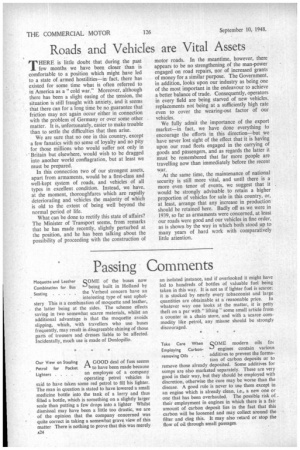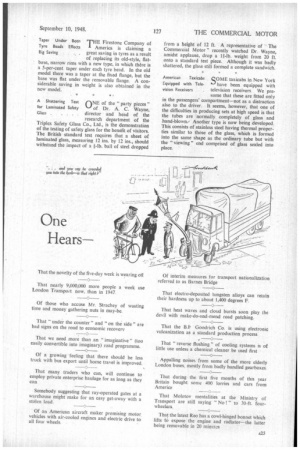Passing Comments
Page 26

Page 27

If you've noticed an error in this article please click here to report it so we can fix it.
Moquette and Leather qomE of the buses now Combination for Bus " being built in Holland by
Seating the Verheul concern have an interesting type of seat upholstery This is a combination of moquette and leather, the latter being at the sides. The scheme effects saving in two somewhat scarce materials, whilst an additional advantage is that the moquette avoids slipping, which, with travellers who use buses frequently, may result in disagreeable shining of those parts of trousers and dresses liable to be affected. Incidentally, much use is made of Dunlopillo.
Our View on Stealing A GOOD deal of fuss seems Petrol for Pocket 4Th to have been made because Lighters . . . . an employee of a company
operating petrol vehicles is said to have taken some red petrol to fill his lighter. The man in question is stated to have lowered a small medicine bottle into the tank of a lorry and thus filled a bottle, which is something on a slightly larger scale than putting a few drops into a lighter Whilst dismissal may have been a little too drastic, we are of the opinion that the company concerned was quite correct in taking a somewhat grave view of this matter There is nothing to prove that this was merely A24 an isolated instance, and if overlooked it might have led to hundreds of bottles of valuable fuel being taken in this way. It is not as if lighter fuel is scarce; it is stocked by nearly every tobacconist and large quantities are obtainable at a reasonable price. In whatever way one looks at the matter, it is petty theft on a par with " lifting " some small article from a counter in a chain store, and with a scarce commodity like petrol, any misuse should be strongly discouraged.
Take Care When SOME modern oils fol Employing Carbon*--4 engines contain various removing Oils . . . additives to prevent the forma tion of carbon deposits or to remove those already deposited. Some additives for sumps are also marketed separately. These are very good in their way, but they should be employed with discretion, otherwise the cure may be worse than the disease. A good rule is never to use them except in an engine which is already clean, i.e., a new one or one that has been overhauled. The possible risk of. their employment in engines in which there is a fair amount of carbon deposit lies in the fact that this carbon will be loosened and may collect around the filter and clog this. It may also retard or stop the flow of oil through small passages. Taper Under Both THE Firestone Company of
Tyre Beads Effects America is claiming a Big Saving great saving in tyres as a result of replacing its old-style, flatbase, narrow rims with a new type, in which there is a 5-per-cent taper under each tyre bead. In the old model there was a taper at the fixed flange, but the base was flat under the removable flange. A considerable saving in weight is also obtained in the new model.
A Shattering Test (NE of the " party pieces" for Laminated Safety ‘-• of Dr. A. C. Wayne, Glass . . . . director and head of the
research department of the Triplex Safety Glass Co., Ltd., is the demonstration of the testing of safety glass for the benefit of visitors. The British standard test requires that a sheet of laminated glass, measuring 12 ins. by 12 ins., should withstand the impact of a 1-lb. ball of steel dropped
from a height of 12 ft. A representative of • The Commercial Motor" recently watched Dr. Wayne, amidst applause, drop a 11-1b. weight from 20 ft. onto a standard test piece. Although it was badly shattered, the glass still formed a complete sandwich.
have been equipped with television receivers We presume that these are fitted only in the passengers' compartment—not as a distraction also to the driver. It seems, however, that one of the difficulties in producing sets at high speed is that the tubes are normally completely of glass and hand-blown Another type is now being developed. This consists of stainless steel having thermal properties similar to those of the glass, which is formed into the same shape as the ordinary tube but with the " viewing" end comprised of glass sealed into place.
Equipped with Television Receivers




















































































